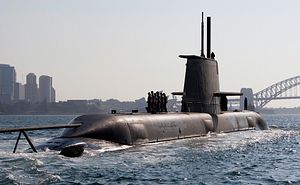This week, the three companies competing to build Australia’s next generation of submarines publicly discussed their proposals at the Submarine Institute of Australia’s third Submarine Science, Technology, and Engineering Conference held in Adelaide, South Australia. The November 30 deadline for the Japanese, German, and French bidders to submit their proposals for a modified Soryu, the Type 216, and the Shortfin Barracuda Block 1A, respectively, is rapidly approaching, and the competition for the $20 billion prize intensifying.
In a dramatic reversal from speculation a year ago that Australia would purchase off-the-shelf submarines from Japan, each bidder has committed to build at Australian Submarine Corporation (ASC) facilities. Germany and France were much quicker to embrace the local build option – out of deference to Australia’s domestic politics – than Japan, which has only recently come around to this position and with great reluctance.
For example, Germany’s ThyssenKrupp Marine Systems (TKMS) has offered to transform Australia into the shipbuilding hub of the Asia-Pacific, a proposal recently echoed by France’s state-controlled DCNS. Japan’s Kawasaki Heavy Industry-Mitsubishi Heavy Industry consortium is willing to build in Australia from day one if required to, but they still prefer a hybrid option.
In addition to considerations about the impact the submarine decision will have on local jobs, technological factors are also critical. As Industry Minister Christopher Pyne told conference participants, “The future submarine will be a unique design for Australia because there are no off-the-shelf solutions that meet our requirements.”
Australia’s submarines will have unique challenges as Mike Yeo, writing for USNI News, points out. Australian submarines will be “expected to operate in a wide range of environments ranging from the cold Southern Ocean to the tropical Coral, Arafura, and Timor Seas. They also need to transit long distances from their base in Australia’s far southwest to their designated patrol areas, which could be as far as the South China Sea and the Northern Pacific.” An important part of the equation for Australian decision makers is which builder has the technological capability to best meet Australia’s needs.
Of course, there are also strategic considerations – former Prime Minister Tony Abbott was known to favor Japan in order to cement the “special relationship” between the two democratic U.S. allies. Even though Abbott’s ousting by Malcolm Turnbull has helped ameliorate the perception of favoritism towards Japan, the underlying logic of a U.S.-Australia-Japan alignment remains sound.
Turnbull replacing Abbott might even end up being a win for Japan – now, if the Japanese option is recommended and chosen, no one can accuse the decision makers of bias and the Japanese bid can be recognized as objectively in the best interest of Australia.
DCNS, for one, is acutely cognizant of the commercial threat that this strategic consideration poses to their bid. In an interesting twist, they have rolled out a new argument: that they are willing to share technological secrets with Australia that they do not share with other states DCNS sells submarines to, such as India, Malaysia, Chile, and Brazil. DCNS said it would share the information because Australia is a Western ally in the same region as French strategic interests in Tahiti, New Caledonia, and the Indian Ocean island of Reunion.
Finally, cooperation with the United States is a key factor. Conventional submarines, which are better at operating in Asia’s shallow coastal waters, can complement and augment the United States’ all-nuclear undersea fleet. Australia’s allergy to nuclear submarines may have started as a liability, by hindering technology cooperation with their patron-ally, but now may be the best guarantor for continued integration between U.S. and Australian forces – and more importantly, their interests.
Australian Defense Minister Marise Payne provided some insight into what the Australian defense community is looking for from their potential partners at the conference: “The selection balances key considerations, including high levels of interoperability with our key ally, the U.S., opportunities to de-risk the combat systems, and synergies arising from commonality between Collins and future submarines.”
The Australian government is expected to decide which international partner Australia will work with early next year – but don’t be surprised if the decision keeps getting pushed off. In Payne’s words, “The Government does not intend to be rushed. This is too important a decision for that.” But a non-decision will have important consequences, as Australia’s neighbors are also modernizing their undersea fleets. Even after a winner is chosen, it will take another three years to finalize the processes and details of the deal.
At the conference, Payne also exhorted the Australian shipbuilding industry to undergo a major “reshaping and reform” during the “lull before the storm” to foster a “productivity-based culture.” After all, it’s not just the submarines contract that shipbuilders must be prepared to deal with. Even though the three-way competitive evaluation process for building eight or 12 submarines has been getting the most attention, the Australian government is also preparing to award contracts for a fleet of frigates to replace the eight ANZAC Class frigates and a new fleet of up to 21 offshore patrol boats in the coming months.
































